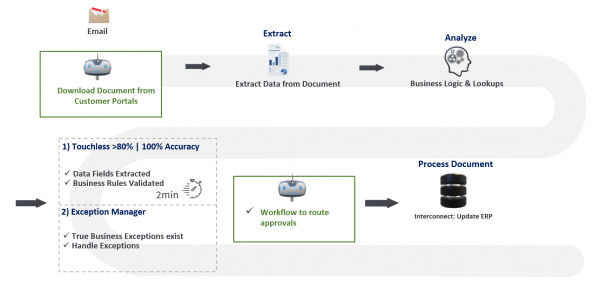Blog Post
If you are considering robotic process automation (RPA) or already well into your RPA strategy, you need to know this: You’re going to hit the proverbial wall.
Why? Because traditional RPA is great at automating static and repeatable tasks, but it needs some support when it comes to automating highly variable documents within variable, complex end-to-end processes.
Full disclosure: Conexiom is not RPA. Or optical character recognition (OCR), for that matter. Our technology is purpose-built to handle complex and variable commercial documents that are unstructured, like purchase orders, invoices, shipping notices, and other business-critical intercompany transactions.
Luckily, we are friends that play well together.
What is RPA?
Let’s take it all the way back to the year 2000, because even though RPA was developed prior to that, it was then that RPA technology came into its own.
RPA 1.0, let’s call it, was essentially bots that were capable of screen-scraping, mouse-clicking, and replacing keystrokes for manual tasks that people were repetitively performing. For example, if you needed to download a report every Thursday and Monday morning, you could easily delegate that task to RPA, and it would perfectly mimic those actions.
Because RPA can execute repetitive tasks really well, it’s perfect for structured data, but in the real world, data is not always so neat. Customers do not use one collective purchase-order template, and each company’s invoices contain varied information that is almost never in the same place across the board.
Along comes RPA 2.0, which is where the technology lives today. This next-generation RPA includes an orchestration of multiple automation technologies (OCR, workflows and analytics) and bots to enhance RPA’s capability to execute a broader and more dynamic range of tasks. However, some challenges still exist regarding data that contains high variability and complexity.
According to Gartner®, “RPA is a non-invasive integration technology used to automate routine, repetitive, and predictable tasks through orchestrated UI interactions that emulate human actions.”
RPA just needs a little help from its friends
When you purchase an RPA tool, there’s typically a grandiose vision around it: The executive team is on board, you have a center of excellence, you articulated your KPIs, and you’re ready to implement the technology.
Generally, the first year is a honeymoon, even with the heavy IT involvement required. Those monotonous tasks are automated, like downloading reports or screen-scraping the web for currency calculations, for example. But after the honeymoon phase, finding more tasks to automate becomes challenging, because after the low-hanging fruit is automated, the more involved tasks, which require cognitive thinking—like processing invoices or POs—are too complex for RPA. So eventually, it cannot continue to automate what you need it to.
What happens next? Developers must update scripts, release them to a testing playground and continually update. A vicious cycle commences, because we don’t do business in a vacuum. Things change, and these changes require bot maintenance… which drains human capital, the very thing you were trying to alleviate through automation.
Gartner® estimates that, by 2022, 80% of RPA-centric automation implementations will derive their value from complementary technologies.
Continuing to maintain RPA is costly, time-consuming and creates technical debt.
In fact, Conexiom customers who have implemented RPA as a solution to automating the processing of business-critical documents share a common opinion: As they looked at the challenge of sales orders, which are complex business documents to automate, the cognitive business logic required to process those orders could not be replicated with RPA alone.
Supercharge RPA with a purpose-built automation platform
Here’s the bottom line: Use RPA to sweat the small stuff, and supplement it with a robust purpose-built platform that can interpret complex, unstructured data that has a high degree of variability.
As an example, here’s how Conexiom and RPA play together to automate document processing without human intervention.

Conexiom works with RPA for a deeper automation experience. RPA can download documents into the Conexiom platform, and after Conexiom extracts and transforms the actual text, RPA handles the workflows and approvals related to each document before it’s released into your system of record.
Learn more about Conexiom’s technology
How Conexiom Transforms Complex Trade Documents into 100% Accurate Touchless Transactions
